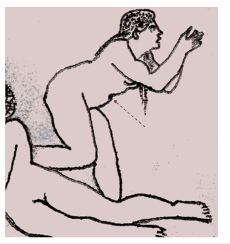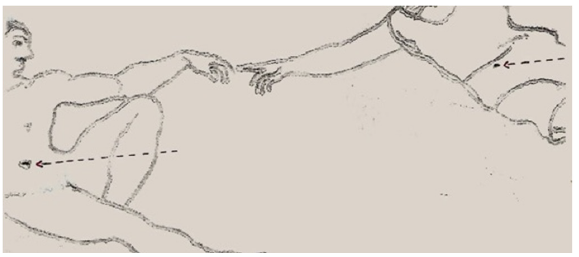- Submissions

Full Text
Archaeology & Anthropology:Open Access
Eve’s Navel
Patrice F Dassonville**
Freelance Researcher, France
*Corresponding author:Patrice FD, Freelance Researcher, Author of the Invention of Time & Space, Springer 2017, France
Submission: October 03, 2023; Published: October 27, 2023

ISSN: 2577-1949 Volume5 Issue1
Abstract
To have a navel means to be born from a woman. Therefore, representing Adam and Eve with a navel is an anachronism.
Keywords:Adam; God; Michelangelo; Sistine Chapel
Introduction
Art history holds hundreds of examples representing Adam and Eve with a navel. This unprecedented observation leads to an amazing example of what is an anachronism (from the Greek “ana”: opposite, and “khrônos”: time): a concept to designate an outdated idea, a kind of violation of temporality [1]. Some famous painters will be mentioned, but the main part of the investigation will be dedicated to Michelangelo and the Sistine Chapel in Rome.
Anachronistic Illustrations
It’s recurring, all artists drew, painted, and still do, Adam and Eve with a navel: among them let’s mention Masaccio in 1427, Albrecht Durer in 1507 (Museo Nacional del Prado in Madrid), Cranach the Elder in 1513, Titian in 1550, as well as Picasso, Chagall, Léger, Gauguin, Otto Müller, Maillol with a sculpture of Eve (c.1905) on display at the Musée d’Orsay in Paris. Given that a navel results from “born from a woman”, these representations are anachronistic, all the more that the Torah does not describe their bodies [2]. Either the artists were unaware of a real problem, or they did not know how to deal with it. To my knowledge, so far, the history of art does not account for this paradoxical iconography (from the Greek “eikôn”: image). But the most amazing illustration is displayed on the Sistine Chapel ceiling in Rome. The pope Julius II (1443-1513) nicknamed “The Terrible”, demanded that Michelangelo paint the Sistine Chapel ceiling, although the artist was convinced that he was a sculptor instead of a painter. The fresco technique, which consists of painting on a thick coating before it’s dry, is very difficult to implement and master. The result of the work (c. 1510) is a feat and the whole ceiling is a masterpiece, even if some compositions have weaknesses.
The Creation of Eve
The pictorial composition (170x260cm) is poor from two points of view. First, Michelangelo was unable to implement a smart solution to deal with the idea of creating Eve from a rib of Adam: standing behind a cute sleeping redhead, the chubby nude girl is in a prayerful position facing a dressed God who seems suspicious with his disproportionate right hand; it reminds us of the huge right hand of his 5m high “David” in Florence. This obvious lack of inspiration is made worse due to the low level of pictorial technique: it looks like a job botched by some student of the master. The umbilical depression of Eve suggests that she was born from a woman instead of an Adam’s rib (Figure 1); accordingly, Eve had a mother.
Figure 1:Fragment of «the creation of eve» with her umbilical depression.

The Creation of Adam
God’s finger brushing against man’s finger is a striking idea that will never be matched. The stripped and remarkably balanced staging has made this huge painting (280x570cm) the most famous and awesome in the world: an absolute masterpiece, in spite of the average quality of the execution of the painting itself, probably in reason of the difficulty of using the fresco technique. Adam has a navel, what indicates that he was born from a woman: therefore, he’s the first man but not the first human. God is wearing a thin tunic, not a coat. The folds of the garment hide his crotch, but not his navel: accordingly, he was born from a woman too (Figure 2). In addition, with his left arm, God hugs a ravishing blonde with bare breasts, while caressing with his left hand the shoulder of a putti; her disapproving gaze seems to foresee a tragedy.
Figure 2:The umbilical depression in Adam (left) and God (right).

The scene is blasphemous. Michelangelo was not an ignorant; as a sculptor, he was well versed in anatomy. Like us today, the pope was amazed by the God’s finger; an unprecedented solution to illustrate the creation of Adam. Michelangelo was obviously not inspired by the topic: the birth of Eve; on the other hand, he surprised everyone, with this unexpected finger of God, towards which all eyes converge. He gave a subversive, but awesome response to the demands of Julius II. Given that the ceiling is 20 meters from the ground, he knew that the pope could not see these provocative details: no risk to enrage “The Terrible”. We know what a navel is, but we are wondering why Michelangelo painted the first man with a navel, the first woman with a navel and God with a navel. A series of strange anachronisms about which anthropology could probably explain why they are commonly accepted, even nowadays. Given that an anachronism is a concept, it’s not observable as such: we can see the navels painted on the Sistine Chapelle ceiling, not the anachronisms of their representation. Perhaps art historians will find the answer to this enigma.
References
- Dassonville P (2017) The Invention of Time and Space.
- Torah L (1966) Latin translation of the Gistini edition in Venice in 1551. French Encyclopedic Society, France.
© 2023 Patrice F Dassonville. This is an open access article distributed under the terms of the Creative Commons Attribution License , which permits unrestricted use, distribution, and build upon your work non-commercially.
 a Creative Commons Attribution 4.0 International License. Based on a work at www.crimsonpublishers.com.
Best viewed in
a Creative Commons Attribution 4.0 International License. Based on a work at www.crimsonpublishers.com.
Best viewed in 







.jpg)






























 Editorial Board Registrations
Editorial Board Registrations Submit your Article
Submit your Article Refer a Friend
Refer a Friend Advertise With Us
Advertise With Us
.jpg)






.jpg)














.bmp)
.jpg)
.png)
.jpg)










.jpg)






.png)

.png)



.png)






